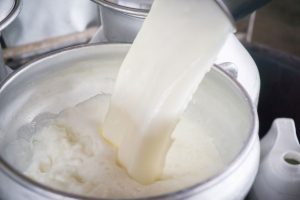Data show significantly higher foodborne illness risks associated with raw milk, yet some consumers still flock to raw milk amid unscientific nutrition beliefs
Milk pasteurization, which is the process of heating milk to a high enough temperature for a long enough time to destroy or deactivate organisms and enzymes that contribute to spoilage or risk of disease, has been around since the 1800s. Thanks for this go to Louis Pasteur, who demonstrated in the 1860s that abnormal fermentation of wine and beer could be prevented by heating the beverages, and to Frans von Soxhlet, a German agricultural chemist, who in 1886, was the first person to suggest that milk sold to the public be pasteurized. The benefits of heating or boiling milk have been recognized since the early 1800s and has been used to reduce milk-borne illness and mortality in infants since the late 1800s. Raw milk can carry dangerous germs, such as brucella, campylobacter, cryptosporidium, E. coli, listeria, and salmonella. Foodborne illnesses such as typhoid, scarlet fever and tuberculosis were virtually eliminated with the commercial implementation of pasteurization.
Fast forward to the year 2020. Despite pasteurization being one of public health’s most effective food safety interventions ever, and despite most of us never having to deal with or lose loved ones to many of the illnesses listed above, there are still raw milk proponents. Some believe that raw milk is more nutritious and contains beneficial bacteria, while some just like the taste and don’t think it’s very risky. And many think that because it’s more natural, it’s better, but the appeal to nature fallacy is never a valid scientific argument.
So, what exactly are the risks and what are the benefits? Let’s do a quick risk analysis.
What are the risks of raw milk?
From 1993 through 2012, 127 outbreaks reported to the Centers for Disease Control and Prevention were linked to raw milk. These outbreaks included 1,909 illnesses and 144 hospitalizations. The average number of outbreaks linked to raw milk each year was four times higher from 2007 through 2012 than from 1993 through 2006. The majority of these outbreaks involve children. At least one child under the age of 5 was involved in 59 percent of these raw milk outbreaks.
It should also be noted that for every outbreak and every illness reported, many others occur. Some raw milk proponents may argue that 127 outbreaks over 19 years isn’t a lot, but the thing you need to remember is that pasteurization can greatly reduce this risk. Also, one must understand that although this number may seem low, no more than 1 percent of the milk consumed in the United States is raw, yet more outbreaks were linked to raw milk than to pasteurized milk. According to the CDC, “The risk of outbreaks linked to raw milk is at least 150 times greater than the risk of outbreaks linked to pasteurized milk.”
On top of the increased risk, outbreaks linked to raw milk tended to cause more severe disease. The hospitalization rate for patients in outbreaks linked to raw milk was 13 times higher than the rate for people in outbreaks linked to pasteurized milk. This is partly due to the fact that the outbreaks due to raw milk were all caused by bacterial infections, which are typically much more severe than the mild viral infections that were common causes of the outbreaks linked to pasteurized milk.
Even raw milk from the most sanitary conditions that has been tested for pathogens carries risk. Negative tests do not guarantee that raw milk is safe to drink as tests don’t always detect low levels of contamination that can still make people very sick. Healthy and clean animals can still carry germs that can contaminate the milk as well. Pasteurizing makes the milk safer, regardless of how clean and sanitary the farm and the animals are.

What are the benefits of raw milk?
OK, so now that we’ve established the fact that consumption of raw milk comes with much greater risk of foodborne illness as compared to pasteurized milk, what are the benefits? Are there any benefits?
There are quite a bit of myths surrounding the supposed benefits of raw milk — for example, many believe raw milk is nutritionally superior to pasteurized milk, but that’s not the case. The protein quality of pasteurized milk is not different from that of raw milk. Minerals are stable under pasteurization conditions, and there is minimal change in their concentrations after pasteurization. Pasteurization has little effect on milk vitamin levels, and the vitamins that are present at high levels in milk, such as riboflavin, B6 and B12, are relatively heat stable.
The only vitamin that is significantly affected by heat is vitamin C, but milk is an insignificant source for vitamin C.
Another argument is that pasteurization kills good bacteria as well as bad bacteria, but bacteria found in raw milk are not probiotic. There are no beneficial bacteria in raw milk for gastrointestinal health. You can get beneficial bacteria from pasteurized fermented foods that aren’t high risk, such as yogurt and kefir. Raw milk is also not an immune-system-building food, and it is particularly unsafe for children. At the low concentrations in milk, bovine immunoglobulins are physiologically insignificant to humans.
In addition, there are no additional protease and lipases in raw milk that help with milk digestion, it does not cure or treat asthma allergy, and it is not more effective in preventing osteoporosis. None of these popular health claims are backed by the evidence.
So, it really is a pretty simple risk analysis. Pasteurized milk provides the same nutritional benefits as raw milk, but comes with significantly less risk of foodborne illness. The choice is quite simple.
If you choose to drink raw milk despite being aware of all of these risks, that is a personal choice, but remember that just because you haven’t gotten sick yet doesn’t mean that raw milk isn’t significantly less safe than pasteurized. Sure, you can reduce the risk by making sure you buy from a sanitary farm that tests each batch, but you can even further reduce that risk with pasteurization. You should also be aware that your choice to purchase and consume raw milk may put other peoples lives at risk as well, as it is especially unsafe for children, pregnant women, older adults and immunosuppressed individuals. It is even against the law to sell raw milk in some places because of the risk it carries.
Pasteurization saves lives. That’s the bottom line. I wonder if Pasteur and von Soxhlet had any idea that 200 years later, people would be shunning their life-saving discoveries due to an idyllic view of the past and unsubstantiated health claims.
Food Science Babe is the pseudonym of an agvocate and writer who focuses specifically on the science behind our food. She has a degree in chemical engineering and has worked in the food industry for more than decade, both in the conventional and in the natural/organic sectors.



